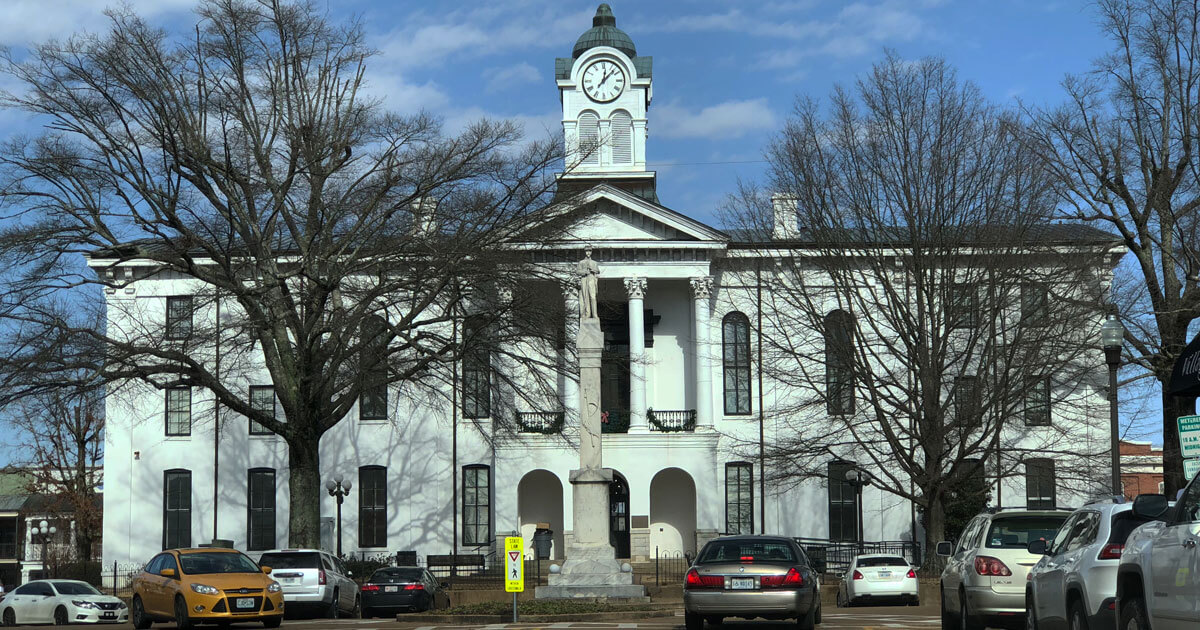
I have quietly done Civil War research on Ole Miss and Oxford, Mississippi for thirty years. Very few people used to care about it. Now, everybody cares about it, and they all think they are experts. I am constantly amazed by the lies, myths, stories, legends, and wrong information I hear from University administrators, professors, students, politicians, and the general public.
The University Confederate monument and the courthouse Confederate monument are tied at the hip. You must understand the University monument to understand the courthouse monument.
The University Confederate monument was erected in 1906 by the United Daughters of the Confederacy (UDC). It took 45 women 14 years to raise $2000 to erect it. Among them were Ole Miss professors’ wives, one instructor, trustees’ wives, Delta Gammas, alumni wives, mothers, and prominent Oxford women (including the mayor’s wife). The whole thing was UM Chemistry Professor R.W. Jones’ idea. They raised money through a national depression (1893–1895) and through the Yellow Fever epidemic (1898). They raised pennies, nickels, and dollars every way they could from cake sales, baby shows, speeches, baseball games, ice cream socials, UM frat and sorority lunches, and more.
The monument is dedicated to the Lafayette County Civil War Confederate dead. It was and is not dedicated to the glory of the Confederacy. It was closure for many, many families and it was the only marker many of those dead ever got.

Twenty-five percent of the men who left Oxford to fight were dead in four years’ time—432 of them. Most did not get a decent burial. At Shiloh, and on most battlefields, they were thrown into mass burial trenches, on top of one another, up to seven deep. And their families knew this. Most of the women who raised money for the monument had lost one or more male relatives in the war. The percentage lost for the South was far greater than World War II. We modern Americans have no earthly idea what those families went through. We have never experienced anything like that.
William Faulkner’s grandmother and aunt did not want “their” monument placed at the University. While they were on an extended trip out of town, the monument arrived by train, and there was a unanimous vote to place it on the University Circle. When Faulkner’s grandmother returned to Oxford and saw the monument at the University, she had a FIT!
She went to the United Confederate Veterans (UCV), Lafayette County Chapter, and told them they had been treated terribly. Most Oxford visitors would not see their monument out there at the University. She talked them into putting up a second monument on the courthouse lawn. It cost $3000 and was two feet higher than the University monument. It took about 18 months to raise the money and install the courthouse monument. Mrs. Falkner died of cancer before the dedication.
Probably after Mrs. Falkner’s death, the UDC and the Oxford Chapter of the Sons of Confederate Veterans joined the UCV in raising the last of the money. All the paperwork I have says the courthouse monument was to be wholly dedicated to the Lafayette County dead. This dedication is on the monument itself. The veterans on one side of the monument praised Confederate women for what they had gone through in the War. The Sons got one side of the monument for an inscription. They called the War a “just and holy cause.” As a Southerner I believe it was. They were leaving a government they thought was not adhering to the Constitution. They sought to leave in peace and they were invaded, pillaged, and killed. I can document 46 Mississippi towns that were burned during the War, including Oxford.
There was never anything racist intended by those two monuments. They were erected by men and women who had lived through losses that we cannot comprehend today. If we lost 25 percent of the 20,000 University students or military-aged Lafayette County men in the next four years, we would put up monuments. That is all those people did.
By the way, do you know that about 30 percent of all Confederates were drafted or driven in by the draft? They did not want to be there, but they did their duty. Kind of like a lot of the Vietnam Vets, who got spit on.
As for the timing of when those monuments went up, it had nothing to do with Jim Crow laws. The nation went Civil War nostalgia crazy in the 1890s, when the first “Big Five” Civil War National Battlefields were formed: Vicksburg, Shiloh, Chattanooga-Chickamauga, Sharpsburg, and Gettysburg. Northerners had already placed statues on their courthouse lawns, because there was money in the North after the War. Mississippi went from the largest per capita income in the nation in 1860 to the lowest in 1870. Southerners had no money until the 1890s.
I have been a member, and named one of two historians, of the 11th Mississippi Memorial Committee put together by Dr. David Sansing. We placed four monuments on three Civil War battlefields. I am currently on the board of directors for the Oxford-Lafayette County Heritage Association, and a board member of Mississippi Civil War Battlefield Commission. I have consulted with the University of Mississippi Contextualization Committee.
I know how those committees work. Everybody throws in something. That is what happened on the courthouse monument. For well over the year of fundraising it was only to be for the county dead. When the UDC and the SCV came on board, with money, in the last months, they were both given a panel for an inscription. The sons wanted to say something nice about their fathers.
I am in possession of papers that seem to indicate the Sons of Confederate Veterans were given a deed for that courthouse monument.
Starke Miller is a local historian with emphasis on the Civil War and University Greys. Starke conducts regular historical tours and seminars on the Ole Miss campus, Oxford, Shiloh, and other Civil War battlefields. He has been engaged in an in-depth research project involving the Confederate Cemetery on campus.




“They called the War a “just and holy cause.” As a Southerner I believe it was. They were leaving a government they thought was not adhering to the Constitution:” I’m glad you at least say you believe it was a worthy cause, At lease we know where you stand. I just can’t understand why people try to just act like the actual declaration doesn’t exist.
A Declaration of the Immediate Causes which Induce and Justify the Secession of the State of Mississippi from the Federal Union. In the momentous step which our State has taken of dissolving its connection with the government of which we so long formed a part, it is but just that we should declare the prominent reasons which have induced our course.
Our position is thoroughly identified with the institution of slavery– the greatest material interest of the world. Its labor supplies the product which constitutes by far the largest and most important portions of commerce of the earth. These products are peculiar to the climate verging on the tropical regions, and by an imperious law of nature, none but the black race can bear exposure to the tropical sun. These products have become necessities of the world, and a blow at slavery is a blow at commerce and civilization. That blow has been long aimed at the institution, and was at the point of reaching its consummation. There was no choice left us but submission to the mandates of abolition, or a dissolution of the Union, whose principles had been subverted to work out our ruin. That we do not overstate the dangers to our institution, a reference to a few facts will sufficiently prove.
Thank you for publishing!!
What a great article. I am so very glad that someone who knows so much about history was able to pin down the facts. I just wish Birmingham would not tear their statue down. The UDC was said to be “part of the clan” and kept to “racist principles”. I have not found that to be true.
Great article that is historically factual in a time where others flat out lie to push their agenda. Thank you to the local voice for allowing this publication. Maybe it will open some eyes about what these monuments are REALLY there for!!
I am grateful to The Local Voice for publishing this important information from Starke Miller.
Thank you The Local Voice for providing us with this crucial information from Starke Miller!
Decisions have often been made out of necessity, this was certainly the case here. At the time during war, one does not have all his needs met. This was the case here decisions were made to the best of officers ability at the time, this was long ago. One would need to be there at the time to understand why the decisions were made.
Please understand why the Ladies were so very determined to put the statues up. This is a memorial to loved ones husbands, sons, fathers, sweethearts and so on . Blacks had nothing to do with memorials . People of those times were subjected to horrible situations, their entire lives were uprooted and in danger. Their way of life was truly changed. And we are screaming about
the COVID 19. What would you all have to say to be caught in a change like the southern women were in?
Go home, be happy you have one, stop marching , raising hell over everything happening.
Do you ever wonder that every thing in this world is not your business.
GOD BLESS AMERICA !!
Thank you for writing this article. I’ve never lived in MS but I have ancestors who lived in Yalobusha County. And I have been to Oxford and loved the beauty of the Square and the statue remembering the dead. As you point out, it was for Southerners a just cause. The only direct ancestor for whom I have proof that he served is my father’s great-great grandfather. To say he fought to preserve slavery is one of the biggest lies ever told! He never owned a slave in his life. He had 10 children (7 of whom he survived!) and they worked his modest farm. Per family stories believed to be accurate, he voluntarily went back to fight 3 times, riding his own horse and using his own gun. He loved his home state of AR and his father’s native MS. He was bitterly opposed to Washington, DC dictating our lives. Interestingly, I feel that exact same way in 2021! We, the silent majority, are allowing ourselves to be controlled by far left wing agendas. Our proud ancestors were not so silent. Their memory should be honored for the courage they had to risk their lives and give up their fortunes to stand up for their beliefs.
Those who would tear down priceless statutes in an attempt to erase our history are ignorant, or sick, petty individuals who are totally unhappy with themselves. If ever they do experience any happiness in life, it appears to be when they are destroying something, or worse yet attacking and killing other human beings who have perpetrated nothing against them.
First off, I live in the South. Oxford is a fine town and a worth visiting and revisiting. Any soldiers who passed are worth mourning, but the cause is something to be ashamed of. The Inscription on the monument reading “a just and holy cause” is objectively false. It is either or a combination of ignorance, denial, revisionism, or belief in the cause of the Confederacy to think it was such a cause. The definition of just is “behaving according to what is morally right and fair”.
Cite the various causes of the civil war you want but what those causes all mean is Slavery. The government telling then they don’t have the right as a state to their property (slaves) and going north to reclaim it.
States rights: was mostly an argument of states rights to choose if slavery would be allowed. Federal laws and state laws were always going to exist and the constitution guarantees equal rights to all, and the federal system is the very basis of our established system of government that we fought for independence to establish, and one that many other governments have been inspired by when forming their constitutions.
Economic issues: Confederate states didn’t believe that their primary economy, mostly in Mississippi, Alabama, and Texas, who’s largest export was cotton, could survive without slave labor even though the north had proven that not to be the case. Texas had already fought a recent civil war to secede from Mexico, and in the Texas constitution guaranteed the slavery of blacks. It is the only constitution to guarantee slavery, not even allowing the existence of free blacks. Slavery was literally the reason for the Texas revolution. They moved into Texas, Mexico had recently gained independence and said no slavery, these Texians said they needed slavery for their economic prosperity. US Civil war was the same. Black people were also just seen and treated as not being equal, hence their treatment in the south immediately after. So it was not a Just cause.
The confederate flag is a participation trophy, and the only time and place in history I’ve ever heard of losers (The Confederacy are losers) getting monuments is the the Southern United States.
The fact that there are things named after Nathan Bedford Forest, the first Grand Wizard of the KKK all over the place in Tennessee and other places is shameful, I don’t care how great a general he was. You don’t name stuff after losers and Klan members unless you support that they were Klan members, and if you feel strongly enough that it stay that way then you refuse to condemn the KKK and slavery. Also, continuing to call Ole Miss the rebels, get over it. Rip off the band-aid and change the name.